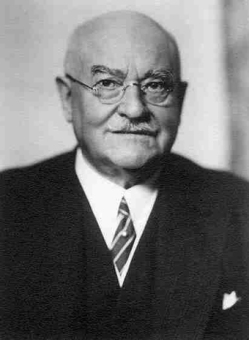Carl Duisberg (1861–1935)

© Bayer AG / Corporate History & Archives, Leverkusen
Carl Duisberg was born in Wuppertal on September 29, 1861, the son of a ropemaker. In 1879, he began studying chemistry in Göttingen and continued his studies in Jena, where he received a Ph.D. in 1882. After one year of military service, he began working as a chemist at Farbenfabrik Friedrich Bayer in Elberfeld in 1883. Here he made several successful dye discoveries in 1885, and in 1900 he became a member of the managing board of Farbenfabriken Bayer. As early as 1896, he had made his first trip to the United States, where he learned about the economic effects of the formation of monopolistic corporations, so-called trusts.
In 1904, Bayer entered into a strategic alliance with Agfa and BASF, a three-member league known as the Dreibund. In 1912, Duisberg became chairman of the management board of the company, now incorporated as Farbenfabriken vormals Friedrich Bayer. During the war, Carl Duisberg served as a consultant to the military authorities. The production of poison gas for combat use was, in addition to the manufacture of explosives, a focal point of the Dreibund’s output: In coordination with Fritz Haber, Bayer AG produced chlorine gas, which was first used by the German army against French troops at Ypres in 1915. The chlorine gas attack resulted in casualties among the French soldiers: between 800 and 1,400 dead and 2,000 to 3,000 injured by the gas. During World War I, Duisberg was one of the trailblazers and vehement advocates of the exploitation of Belgian POWs as forced laborers. The Dreibund made a substantial contribution to prolonging the war, particularly by overcoming the ammunition crisis. In 1919, Duisberg declared, in a speech to respresentatives of industry:
“As the situation is today, it surely would be better for all of us if we had not exerted ourselves to such an extent, or if we had failed. Then the war would have been at an end shortly after its outbreak. Thereby, both for us and for the entire civilized world, the European world, we would have avoided that sad condition from which we all suffer today, and not only we, but the other nations as well.”[1]
Duisberg was awarded honorary doctorates from the universities of Bonn, Tübingen, Cologne, Berlin, and Heidelberg, among others.
In 1925, along with Carl Bosch, he played a decisive role in the founding of I.G. Farbenindustrie AG, and the following year he became chairman of its supervisory board. The goal of this integration was the “elimination of ruinous competition, with the aim of achieving the highest possible profits.”[2] Duisberg, as chairman of the supervisory board of I.G. Farbenindustrie, was responsible for personal data, overall organization, statistics, and various branches of production. In 1931, in a talk before the Düsseldorf Chamber of Industry and Commerce, he called for the creation of a German-dominated European economic bloc.
The leading representatives of I.G. Farben, who sat in the Reichstag for various parties in order to force through corporate policy interests, fine-tuned their positions in the so-called Kalle circle. To enhance the safeguarding of I.G. Farben’s interests, Duisberg further developed the “system” of financial donations to political parties, by systematically having money distributed to several parties at the same time. Support was given to the conservative to völkisch-nationalistic DNVP (German National People’s Party) and to the Zentrum (Center Party), anchored in the Catholic milieu, as well as to both liberal parties, the national liberal DVP (German People’s Party) and the left-liberal DDP (German Democratic Party). From 1931 on, support also was given to the NSDAP (National Socialist German Workers’ Party).
Duisberg himself campaigned for the reelection of Hindenburg in the Reich presidential election of 1932. The initial rejection of NSDAP policies was quickly abandoned by I.G. Farben for reasons of economic policy. In 1931, the NSDAP received its first party donation from I.G. Farben, and after Hitler was named Reich chancellor, the NSDAP received its largest single donation from any source to date: 400,000 RM. Two years after the transfer of power to the National Socialists, Carl Duisburg died in Leverkusen on March 19, 1935.
(SP; transl. KL)
















